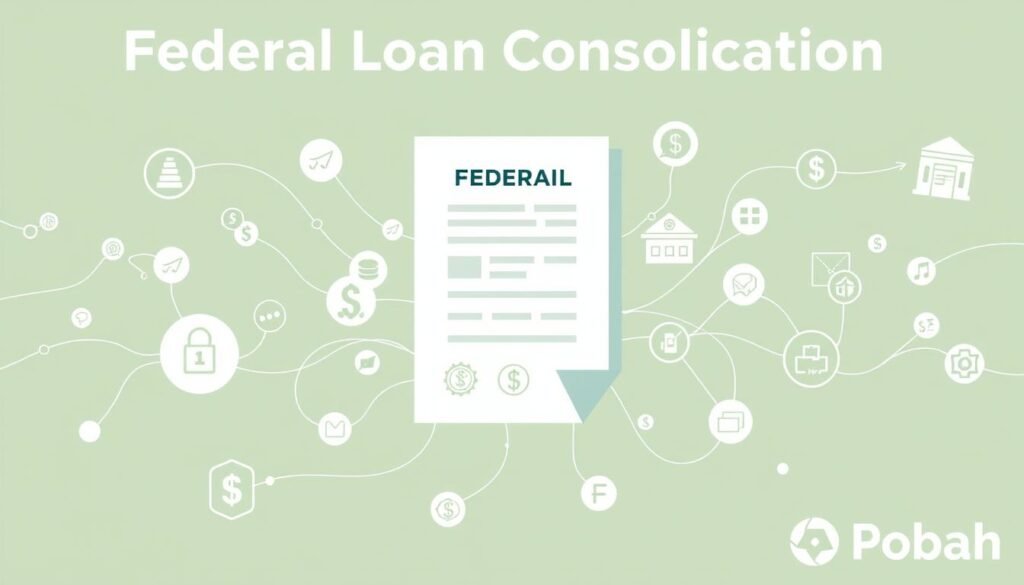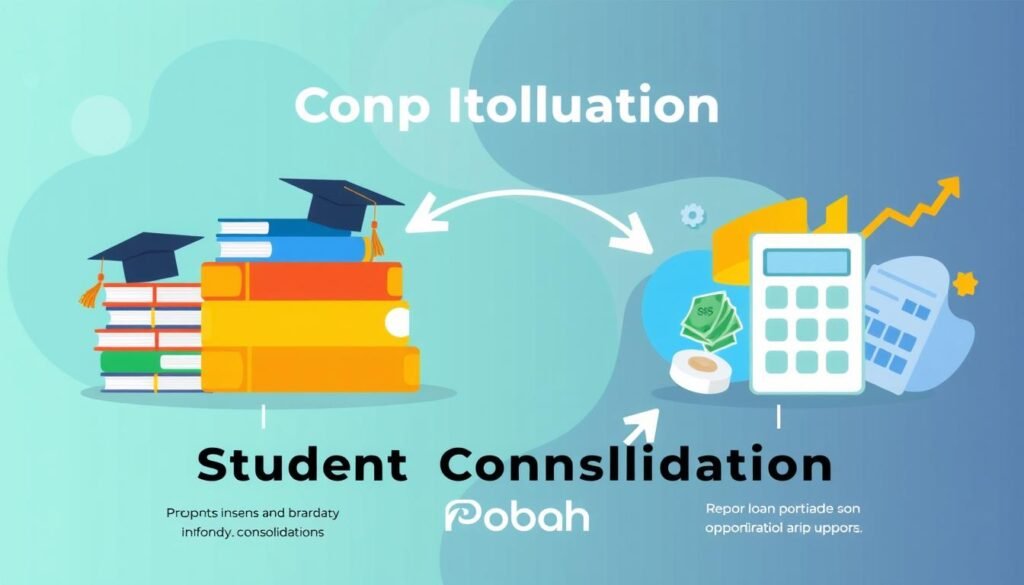Feeling overwhelmed by multiple student loans? This *ultimate guide to student loan consolidation* is here to help. It shows how to combine your loans into one, easier-to-manage loan. This can make your monthly payments simpler and might even lower your interest rates.
But, it’s important to know the potential downsides. Not all consolidation plans are the same. In this guide, we’ll dive into the details of student loan consolidation. We aim to give you the insights you need to make smart choices about your financial future.
Key Takeaways
- Student loan consolidation helps simplify your debt management.
- Combining loans can potentially lower your interest rates.
- It is important to consider both benefits and drawbacks before proceeding.
- Understanding the types of consolidation is key to selecting the best option for you.
- This guide will extensively cover everything you need to know about student loan consolidation.
Understanding Student Loan Consolidation
Student loan consolidation means combining several loans into one. This makes paying back easier and might lower your interest rate. You can merge both federal and private loans, making debt management simpler.
Before you decide to consolidate, know your financial situation well. Look at your current loans, interest rates, and total debt. Also, think about how it might affect your credit score and the new loan’s terms.
Here’s a look at different loans you can consolidate:
| Loan Type | Eligible for Consolidation | Interest Rate Influence |
|---|---|---|
| Federal Loans | Yes | Fixed rate based on average of existing loans |
| Private Loans | Yes | Variable or fixed, depends on lender |
| Alternative Loans | Depends on lender | May vary significantly |

What You Need to Know About Federal Loan Consolidation
Federal loan consolidation helps simplify your student debt. It combines multiple federal student loans into one. This can make your monthly payments easier and open up special repayment programs.
It’s key to know if you qualify before you start the application process. This will help you understand if you can benefit from it.
Eligibility for Federal Loan Consolidation
To qualify for federal loan consolidation, you need to meet certain criteria. The following types of federal loans are eligible:
- Direct Loans
- Federal Family Education Loans (FFEL)
- Perkins Loans
- Other federal student loans
You also need to be in a repayment status or have graduated, withdrawn, or dropped below half-time enrollment. There are no credit score requirements. This makes it accessible to many borrowers.
Application Process for Federal Loan Consolidation
The application process for federal loan consolidation is easy. You can apply online through the Federal Student Aid website. You’ll need to provide important documents, such as:
- Your federal student loan information
- Your personal identification details
- Preferred loan servicer details if applicable
It’s crucial to understand the rules of your loan servicer. They will manage your consolidated loan after approval. Always review the terms and conditions carefully. They can differ based on your servicer.

The Ultimate Guide to Student Loan Consolidation: Benefits, Drawbacks
In this guide, learning about loan consolidation benefits is key. It can make your payments easier to handle each month. Instead of dealing with many payments, you get one, which can reduce stress a lot.
Another big plus is the chance for lower interest rates. If you qualify, you might get a lower rate. This can save you a lot of money over time, helping you with other expenses or saving for later.

But, it’s also important to think about the pros and cons of consolidation. A big drawback is losing borrower benefits. Federal loans might offer forgiveness or lower rates, which you could lose. Make sure these benefits are worth the loan simplification.
Also, consider the repayment term. Even if payments are lower, a longer term means more interest. This could mean you’re paying more than you expected for longer.
| Aspect | Benefits | Drawbacks |
|---|---|---|
| Monthly Payments | Easier to manage with one payment | May not be applicable if terms extend |
| Interest Rates | Potentially lower rates | Risk of higher overall interest costs |
| Borrower Benefits | Consolidation can simplify terms | Possible loss of perks from original loans |
| Loan Management | Simple billing solution | Requires careful evaluation of loan types |
Knowing both sides helps you make better choices for your money. By understanding the guide to student loan consolidation, you can choose wisely.
Private Loan Consolidation: A Closer Look
Understanding private loan consolidation is key when looking at student loan options. It can change your financial situation a lot. This is especially true when you compare it to federal loan consolidation.
Differences from Federal Loan Consolidation
Private loan consolidation is very different from federal loan consolidation. Here are some main differences:
- Interest Rates: Private lenders charge higher interest rates based on your credit score.
- Eligibility Requirements: Private loans are not as easy to get as federal loans. They often look at your credit and income.
- Loan Benefits: Private loans usually don’t offer the same protections as federal loans. This includes things like income-driven repayment plans and forgiveness options.
Choosing a Private Lender for Consolidation
Choosing a private lender for consolidation needs careful thought. Look at these factors to make a good choice:
- Interest Rates: Compare different lenders to find the best rates.
- Fees: Check for any origination or prepayment fees that could increase your costs.
- Loan Terms: Look at the repayment options and see if they fit your financial goals.
Also, ask questions like:
- What happens if I miss a payment?
- Are there options for deferment or forbearance?
- What kind of customer support do you offer?
Pros and Cons of Consolidation
Thinking about student loan consolidation? It’s important to know the good and bad sides. The pros and cons can really affect your money situation. So, take your time to think about them.
Key Benefits of Consolidating Your Student Debt
Student loan consolidation has some big pluses:
- Streamlined payments: You merge all your loans into one. This makes tracking payments a breeze.
- Lower interest rates: You might get a better interest rate than your current loans.
- Easier budget management: One payment a month can help you budget better and reduce stress.
Potential Drawbacks You Should Consider
But, there are also downsides to think about:
- Loss of federal protections: Private lenders might take away benefits like loan forgiveness.
- Capitalization of interest: Unpaid interest can add to your debt.
- Impact on repayment flexibility: Consolidation might limit your repayment options.
Exploring Student Loan Refinancing Options
Student loan refinancing can help you get lower interest rates and easier payments. It’s different from consolidation, which just combines loans without changing rates. When you refinance, you apply for a new loan from a private lender to pay off your old ones. This can save you money, especially if you get a lower rate because of your credit score and financial history.
Before you start with student loan refinancing, think about these things:
- Credit Score: Lenders check your credit. A better score means better rates.
- Financial History: A steady income and good repayment history help your application.
- Loan Types: Know the loans you want to refinance. Federal loans are different from private ones.
The refinancing process includes picking a lender, sending in documents, and a credit check. Each lender has its own rules, so it’s key to compare offers. By choosing wisely, you can improve your financial health a lot.
Strategies for Consolidating Student Debt Effectively
Managing student debt requires smart strategies. Consolidating loans can make payments easier and lower monthly costs. First, you need to understand your current loans well.
Evaluating Your Current Loans
Before you start, review your loans carefully. Check the interest rates, how much you owe, and repayment terms. This info helps you see your financial situation clearly.
Use a table to organize your loans:
| Loan Type | Balance | Interest Rate | Monthly Payment |
|---|---|---|---|
| Federal Loan | $15,000 | 4.5% | $200 |
| Private Loan | $10,000 | 6.0% | $150 |
This review helps you choose the best loans to consolidate. Loans with high interest rates are often the first to go.
Setting Goals for Consolidation
When planning your consolidation, set clear financial goals. Decide if you want to reduce monthly payments or pay off debt quickly. Knowing your goals helps you make the right choices.
Combining your loans can simplify payments and save money. By focusing on your goals and understanding your loans, you’re on the right path to managing your debt.
Student Loan Repayment Options After Consolidation
After you consolidate your student loans, you have several repayment options. It’s important to understand these to fit them to your financial situation. You can choose from income-driven plans that adjust with your income or fixed plans that last longer.
Choosing the right option is key to managing your loan payments after consolidation.
Income-Driven Repayment Plans
Income-driven plans adjust your payments based on your income and family size. They offer relief with lower payments and may lead to loan forgiveness after years. If you’re facing financial challenges or unexpected changes, these plans could help.
Standard vs. Extended Repayment Plans
Understanding the difference between standard and extended plans is crucial. The standard plan has fixed payments for 10 years. The extended plan offers longer terms, from 12 to 25 years, for lower monthly payments but more interest paid overall.
Consider these options carefully to find the best fit for your finances.
Common Myths about Student Loan Consolidation
Understanding student loan consolidation is key to smart financial choices. But, myths can confuse and mislead. Let’s clear up these misconceptions.
- Myth 1: All federal loans can be consolidated into a single payment without repercussions.
- Myth 2: Consolidation always results in lower monthly payments.
- Myth 3: You lose benefits when you consolidate your federal loans.
- Myth 4: Consolidated loans cannot be split up later.
- Myth 5: You cannot consolidate if you are in default.
These myths can affect your financial plans. Consolidation might simplify payments but can also raise your total cost and repayment time. Knowing these myths helps you choose wisely.
| Myth | Reality |
|---|---|
| All federal loans can be consolidated easily. | Not all loans qualify for consolidation, and certain conditions must be met. |
| Consolidation always means lower payments. | Payments can actually increase if you extend the repayment term. |
| Consolidation eliminates existing benefits. | Some benefits can continue, but it depends on the loan type. |
| Consolidated loans can never be separated. | You can explore options to refinance or split qualifying loans later. |
| You cannot consolidate if you’re in default. | You may be able to rehabilitate the loan before consolidation. |
Knowing the truth is vital. By debunking these myths, you can make better financial choices.
Conclusion
In this ultimate guide to student loan consolidation, we’ve covered a lot. You now know the good and bad sides of it. Consolidating your loans can make payments easier, lower interest rates, and fit your budget better. But, you might lose some benefits from your old loans.
Think about your financial goals and how consolidation affects you. Making smart choices can turn a tough situation into a manageable one. It’s more than just money; it’s a step towards a better financial future.
The choice to consolidate is yours. But knowing what you’re getting into is key. Use what you’ve learned to handle your student loans. Taking action now can lead to a more secure future, with consolidation as a powerful tool.
FAQ
What is student loan consolidation?
Student loan consolidation means combining several loans into one. This makes paying back easier. It can also lower your monthly payments.
What are the benefits of student loan consolidation?
Consolidation offers simpler payments and might lower interest rates. It also helps with budgeting by having just one payment.
What are the drawbacks of consolidating student loans?
Some downsides include losing special benefits from your original loans. It might also extend repayment time, leading to more interest paid. Your credit score could also be affected.
How does federal loan consolidation differ from private loan consolidation?
Federal consolidation often comes with benefits like income-driven plans and fixed rates. Private consolidation might have higher rates and less flexibility.
What is the application process for federal loan consolidation?
To apply for federal consolidation, use the Direct Consolidation Loan program. You’ll need to fill out an online form on the Federal Student Aid website. You might also need to provide loan details.
Can I refinance my student loans after consolidation?
Yes, you can refinance after consolidation. This involves getting a new loan from a private lender to replace the consolidated one. The goal is usually to get a lower interest rate.
What are some student loan repayment options after consolidation?
After consolidation, you have several repayment choices. These include income-driven plans that adjust payments based on income. You also have standard and extended plans that change payment length and amount.
What strategies should I consider before consolidating my student debt?
Before consolidating, review your current loans’ terms and rates. Think about your financial goals. Decide if you want short-term relief or long-term savings.
Are there any common myths about student loan consolidation?
Yes, one myth is that all federal loans can be consolidated without issues. But, consolidation can change your repayment options and might not always lower payments.




